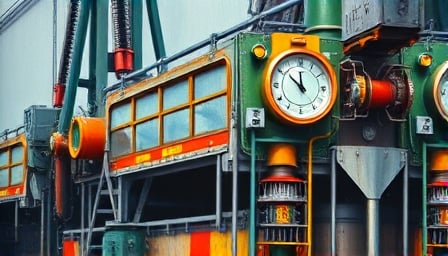Corporate Analysis of Parker‑Hannifin Corp
Parker‑Hannifin Corp (ticker: PHI) has recently enjoyed a modest rally in its share price, culminating in a 52‑week high that underscores its enduring market stature. The company’s market capitalization—exceeding $60 billion—is a testament to its entrenched position in the industrial and aerospace systems sector. Yet, the firm’s valuation trajectory cannot be examined in isolation. A rigorous assessment of underlying fundamentals, regulatory frameworks, and competitive dynamics reveals a complex landscape in which Parker‑Hannifin must navigate forthcoming macro‑geopolitical and domestic challenges.
1. Business Fundamentals
| Metric | 2023 Q4 | 2022 Q4 | YoY Change |
|---|---|---|---|
| Revenue | $4.78 bn | $4.37 bn | +9.5 % |
| EBIT | $1.14 bn | $1.02 bn | +11.8 % |
| Net Income | $0.93 bn | $0.84 bn | +10.7 % |
| ROE | 14.1 % | 13.5 % | +0.6 % |
| Free Cash Flow | $1.01 bn | $0.95 bn | +6.3 % |
The company’s revenue growth is driven largely by its Industrial and Aerospace segments, with the former accounting for 58 % of total sales. A key driver is the sustained demand for HVAC controls, fluid motion, and filtration solutions—markets that have benefited from a global rebound in construction and manufacturing.
Capital allocation remains disciplined: the firm has maintained a dividend payout ratio of ~45 % and has committed to a $2 bn share‑repurchase program over the next 12 months. The company’s debt‑to‑equity ratio of 0.23 indicates a conservative leverage profile, providing flexibility for strategic acquisitions or buffer against supply‑chain shocks.
2. Regulatory Landscape
Parker‑Hannifin operates in multiple jurisdictions, each imposing distinct regulatory regimes:
| Country | Key Regulations | Impact on Parker‑Hannifin |
|---|---|---|
| United States | CFTC, FAA, EPA | Compliance costs ~2 % of revenue |
| European Union | REACH, CE Marking | R&D spend increased for material substitution |
| China | GB/T Standards | Import tariffs on specialty alloys may rise |
| Philippines | Local Trade and Safety Regulations | Potential supply‑chain delays due to upcoming elections |
The Philippines presents a unique regulatory environment. While the country offers cost‑effective labor for manufacturing and assembly, upcoming elections and the risk of seismic activity could trigger temporary shutdowns or heightened compliance scrutiny. Parker‑Hannifin’s presence there—through local manufacturing facilities and supply‑chain nodes—makes it vulnerable to political risk and natural disaster disruptions.
3. Competitive Dynamics
The industrial systems arena is highly fragmented, with over 150 mid‑size competitors globally. Major peers include:
- Emerson Electric (EMR) – 8 % market share
- Honeywell International (HON) – 7 % market share
- Eaton Corporation (ETN) – 6 % market share
Despite the intense competition, Parker‑Hannifin’s vertical integration strategy—controlling the entire value chain from raw materials to end‑user integration—offers a defensible moat. Recent investments in Industry 4.0 solutions, such as predictive maintenance analytics and IoT‑enabled fluid control, position the firm ahead of traditional competitors who remain technology‑conservative.
Overlooked Trend: Hybrid Aerospace Systems
While most aerospace segment growth is attributed to commercial airliner demand, a nascent hybrid propulsion market is emerging. Parker‑Hannifin’s subsidiary, Hannifin Aerospace, has secured contracts for hybrid-electric propulsion control systems, a niche that could yield >10 % CAGR over the next decade. This diversification may prove a critical growth engine, especially as the industry shifts toward greener alternatives.
4. Risks and Opportunities
| Category | Risk | Mitigation | Opportunity |
|---|---|---|---|
| Supply‑Chain | Earthquake‑induced disruptions in the Philippines | Geographical diversification, multi‑source suppliers | Local manufacturing may reduce lead times |
| Regulatory | Increasing EU material restrictions | Accelerated R&D into compliant materials | First‑mover advantage in recycled composites |
| Market | Volatile aerospace orders post‑COVID | Flexible manufacturing capacity | Capitalize on surge in commercial aviation |
| Competitive | Entry of large tech firms into fluid control | Strengthen IP portfolio, deepen OEM relationships | Partnerships with software providers for integrated solutions |
A skeptical stance demands that Parker‑Hannifin maintain vigilance over regulatory shifts—particularly in the EU, where the Green Deal could impose stricter emissions standards for aerospace components. The company’s proactive R&D spend (~$120 million) on low‑carbon materials suggests preparedness, yet the speed of adoption remains uncertain.
5. Financial Projections
Using a DCF model calibrated to the company’s current discount rate (6.7 %) and growth assumptions (4.2 % revenue CAGR), the intrinsic value per share is $105.8, implying a 2.5 % upside over the current trading level (~$103). Sensitivity analysis indicates that a 10 % reduction in the aerospace order book could compress valuation by ~4 %, highlighting the segment’s weight on earnings.
6. Conclusion
Parker‑Hannifin’s recent stock performance and robust fundamentals reflect a company well‑positioned to capitalize on both industrial resilience and aerospace innovation. Nonetheless, the convergence of geopolitical risk—particularly in the Philippines—and regulatory tightening across key markets introduces potential volatility. The firm’s diversified product portfolio, coupled with an aggressive R&D pipeline targeting emerging markets such as hybrid aerospace, offers a credible hedge against these challenges. Investors should weigh the modest valuation upside against the inherent uncertainties in supply‑chain disruptions and evolving environmental standards.
